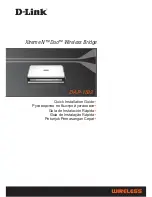
6 - 13
1. Select the
Configuration
tab from the Web UI.
2. Select
Wireless.
3. Select
Wireless LANs
to display a high level display of existing WLANs.
4. Select the
Add
button to create an additional WLAN, or select an existing WLAN and
Edit
to modify its properties.
5. Select
Security
.
6. Refer to the
MAC Registration
field within the WLAN security screen.
Select the
MAC Registration Enable
option if quick access is required with the selected WLAN. This feature is disabled
by default.
7. Select the RADIUS group name from the
Radius Group Name
drop-down list. A RADIUS group is a collection of user
accounts that have same permissions.
8. Select
Expiry Time
. This is the duration for which MAC addresses are stored on the wireless controller’s database. Once
this time expires, the user information is purged from the database. The user then has to provide login credentials as well
as identification information again.
9. Select
OK
when completed to update the MAC Registration configuration. Select
Reset
to revert the screen back to the
last saved configuration.
6.1.2.6 External Controller
Configuring WLAN Security
External controller configuration enables this WLAN to be managed by a remote wireless controller. This feature is disabled
by default.
To configure the external server information:
1. Select the
Configuration
tab from the Web UI.
2. Select
Wireless.
3. Select
Wireless LANs
to display a high level display of existing WLANs.
4. Select the
Add
button to create an additional WLAN, or select an existing WLAN and
Edit
to modify its properties.
5. Select
Security
.
6. Refer to the
External Controller
field within the WLAN security screen.
7. Select the
Enable
option to enable this WLAN to be managed by an external controller.
8. Use the
Host
field to enter a host name/IP address of the remote wireless controller. Use the spinner control to select the
type of the remote controller.
9. Use the
Proxy Mode
drop-down to configure the proxy mode for accessing remote resources.
10. Select
OK
when completed to update the External Controller configuration. Select
Reset
to revert the screen back to the
last saved configuration.
6.1.2.7 WPA/WPA2-TKIP
Configuring WLAN Security
Wi-Fi Protected Access
(WPA) is an encryption scheme specified in the IEEE
Wireless Fidelity
(Wi-Fi) standard, 802.11i. WPA
provides more sophisticated data encryption than WEP. WPA is designed for corporate networks and small-business
environments where more wireless traffic allows quicker discovery of encryption keys by an unauthorized person.
The encryption method is
Temporal Key Integrity Protocol
(TKIP). TKIP addresses WEP’s weaknesses with a re-keying
mechanism, a per-packet mixing function, a message integrity check, and an extended initialization vector, however TKIP also
has vulnerabilities.
Содержание WiNG 5.4.2
Страница 1: ...Motorola Solutions WiNG 5 4 2 ACCESS POINT SYSTEM REFERENCE GUIDE ...
Страница 2: ......
Страница 20: ...xvi WiNG 5 4 2 Access Point System Reference Guide ...
Страница 24: ...1 4 WiNG 5 4 2 Access Point System Reference Guide ...
Страница 36: ...2 12 WiNG 5 4 2 Access Point System Reference Guide ...
Страница 54: ...3 18 WiNG 5 4 2 Access Point System Reference Guide ...
Страница 358: ...6 2 WiNG 5 4 2 Access Point System Reference Guide Figure 6 1 Configuration Wireless menu ...
Страница 453: ...6 97 Figure 6 45 Advanced Rate Settings 2 4 GHz screen Figure 6 46 Advanced Rate Settings 5 GHz screen ...
Страница 462: ...6 106 WiNG 5 4 2 Access Point System Reference Guide ...
Страница 474: ...7 12 WiNG 5 4 2 Access Point System Reference Guide ...
Страница 509: ...9 5 Figure 9 2 Captive Portal Policy screen Basic Configuration tab ...
Страница 572: ...11 12 WiNG 5 4 2 Access Point System Reference Guide ...
Страница 608: ...12 36 WiNG 5 4 2 Access Point System Reference Guide Figure 12 38 Certificate Management Import New Trustpoint screen ...
Страница 626: ...12 54 WiNG 5 4 2 Access Point System Reference Guide ...
Страница 790: ...A 2 WiNG 5 4 2 Access Point System Reference Guide ...
Страница 835: ......
















































